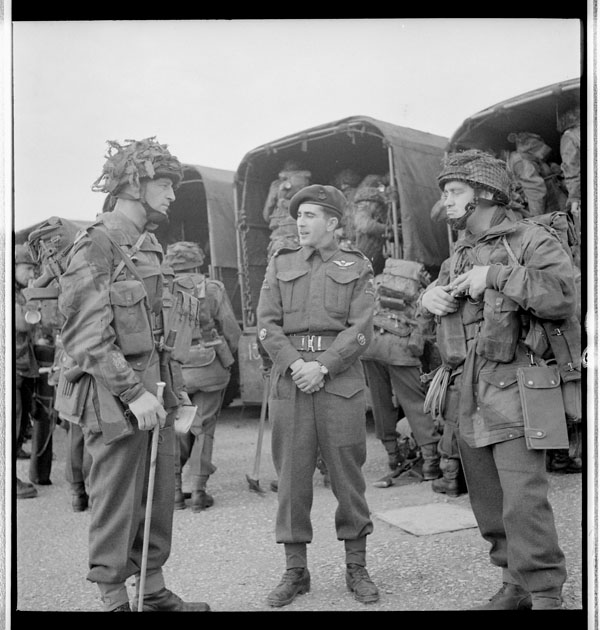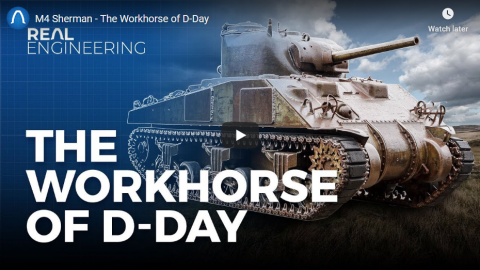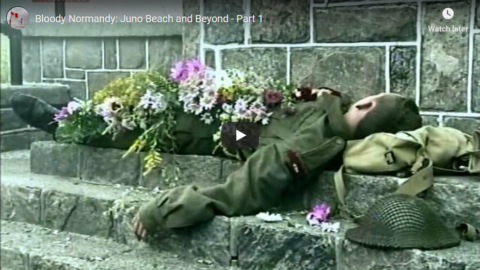Real Engineering
Published on 21 Sep 2019Watch over 2,400 documentaries for free for 30 days by signing up at http://www.CuriosityStream.com/realen… and using the code, “
realengineering”New streaming platform: https://watchnebula.com/
Patreon:
https://www.patreon.com/user?u=282505…
Twitter:
https://twitter.com/thebrianmcmanus
Discord:
https://discord.gg/s8BhkmNThank you to AP Archive for access to their archival footage
September 23, 2019
M4 Sherman – The Workhorse of D-Day
August 27, 2019
The Secret Invention That Made D-Day Possible | INTEL
Forces TV
Published on 7 Jun 2019As much as the success of D-Day was down to the bravery of soldiers … it was made possible by inventions and new machines. These Mulberry Harbours were a real World War 2 engineering victory.
More Mulberry: https://www.forces.net/d-day/mulberry-harbours-how-allies-floated-concrete-win-d-day
Forces Net D-Day Hub: http://forces.net/dday
June 7, 2019
The almost-forgotten 1st Canadian Parachute Battalion on D-Day
Colby Cosh reminds us that Canadian troops landed in Normandy in at least one other location than on Juno Beach:

From left to right, Regimental Sergeant-Major “Knobby” Clark, Company Sergeant-Major Norbert Joseph and Company Sergeant-Major Outhwaite of the 1st Canadian Parachute Battalion getting ready to leave Carter Barracks for their D-Day transit camp, May 1944.
Canada. Dept. of National Defence / Library and Archives Canada / e002852749
Col. C.P. Stacey’s 1946 history of 1st Canadian Parachute Battalion in Normandy describes the expectations of high command chillingly. For the purposes of the invasion, the Canadians operated as a component of the British 6th Airborne Division, assigned to blow up bridges, seize crossroads and establish advance observation posts deep in enemy territory. The War Office estimated, Stacey wrote, “that the wastage for the first month would be at the double intense rate, i.e., 50 per cent of War Establishment for officers and 40 per cent for other ranks.”
With regard to the Canadian airborne, this accounting proved largely accurate: 541 men from the battalion left England to be dropped into the battle of Normandy, the enumerated casualties for June 6 alone were two “presumed killed,” 18 dead, six wounded, and 81 taken prisoner. The unit lost no more to capture after the first day, but by June 17, when the battalion was removed from the front line for the first time, the other categories had swelled to 48 killed and 113 wounded. Stacey’s calculation of the actual “wastage” rate is that it was 59 per cent for officers and 39 per cent for other ranks.
If you have read about the paras, it is perhaps not the casualty figures that strike you so much as the unique Gothic horror of their particular experience of D-Day. The Americans’ use of parachute attacks in Sicily had taught planners that putting soldiers right on the intended drop zone never went as well as in training. Pilots who were comfortable flying slow and at suitable height over Fort Benning inevitably found themselves less cool over enemy terrain dotted with anti-aircraft guns and small arms.
In some cases evasive manoeuvres flung the airborne infantry out of the hatch without warning. Meanwhile, flat areas that had looked like green fields in photos turned out to be algae-covered swamps, some intentionally flooded by the Germans. Anyone who had volunteered for the paratroops in the hope of avoiding drowning could be in for a dreadful surprise. The historian Dan Hartigan, son of a 1st Battalion vet of the same name, describes a close shave for Sgt. W.R. Kelly, later killed in the Battle of the Bulge. “One man found Sergeant Kelly hanging upside down with his head in the water, from a huge deadwood tree. … The canopy had caught on a limb and suspended Kelly so he was submerged from the top of his head to his neck.” Kelly was rescued by a nearby comrade, but some soldiers in similar predicaments dropped alone and were not so lucky. In darkness and confusion, others landed badly, broke limbs, and were out of action at once.
June 6, 2019
On D-Day what did the Germans know?
Military History Visualized
Published on 28 May 2019When it comes to D-Day and the German perspective there are a few bits out there, but the sources are sometimes lacking. So, for this, we will be looking at some proper sources namely, the situation report of Operations Staff of the Wehrmacht and the war diary of the 7th German Army.
Cover design by vonKickass.
»» SUPPORT MHV ««
» paypal donation – https://paypal.me/mhvis
» patreon – https://www.patreon.com/mhv» SOURCES «
Mehner, Kurt (Hrsg.): Die geheimen Tagesberichte der Deutschen Wehrmachtführung im Zweiten Weltkrieg 1939-1945. Band 10: 1. März 1944 – 31. August 1944, Biblio Verlag: Osnabrück, 1985.
Schramm, Percy E.: (Hrsg.): Kriegstagebuch des OKW 1944-1945. Teilband I. Eine Dokumentation. Bechtermünz: 2005.
Lieb, Peter: Unternehmen Overlord. Die Invasion in der Normandie und die Befreiung Westeuropas. C.H. Beck: München, 2014.
Horst Boog, Gerhard Krebs, Detlef Vogel: Das Deutsche Reich und der Zweite Weltkrieg. Band 7. Das Deutsche Reich in der Defensive – Strategischer Luftkrieg in Europa, Krieg im Westen und in Ostasien 1943 bis 1944/45, Deutsche Verlags-Anstalt, Stuttgart 2001.
Germany and the Second World War. Volume 7. The Strategic Air War in Europe and the War in the West and East Asia 1943–1944/5. 2006.
Citino, Robert M.: The Wehrmacht’s Last Stand. The German Campaigns of 1944-1945. University Press of Kansas: USA, 2017.
Fennell, Jonathan: Fighting the People’s War. The British and Commonwealth Armies and the Second World War. Cambridge University Press: Cambridge, UK, 2019
Harrison, Gordon A.: Cross-Channel Attack. United States army in World War II. Center of Military History, United States Army, Washington D.C., 1993
Blumenson, Martin: Breakout and Pursuit. United States army in World War II. Center of Military History, United States Army, Washington D.C., 1993
Messenger, Charles: The D-Day Atlas. Anatomy of the Normandy Campaign, Thames & Hudson: London, 2014 (2004).
Penrose, Jane (ed.): The D-Day Companion. Leading Historians explore history’s greatest amphibious assault. Osprey Publishing: Oxford 2009 (2004).
Töppel, Roman: Kursk 1943. The Greatest Battle of the Second World War. Helion: Warwick, UK: 2018.
Document for June 6th: D-day statement to soldiers, sailor, and airmen of the Allied Expeditionary Force, 6/44 https://www.archives.gov/global-pages…
The Invasion of France, June 6, 1944, House of Commons https://winstonchurchill.org/resource…
Bloody Normandy: Juno Beach and Beyond – Part 1
canmildoc
Published on 17 Sep 2011Part 1 of 5
Documentary “Stories from the Second World War: Bloody Normany”.
Juno or Juno Beach was one of five sectors of the Allied invasion of German-occupied France in the Normandy landings on 6 June 1944, during the Second World War. The sector spanned from Saint-Aubin, a village just east of the British Gold sector, to Courseulles, just west of the British Sword sector. The Juno landings were judged necessary to provide flanking support to the British drive on Caen from Sword, as well as to capture the German airfield at Carpiquet west of Caen. Taking Juno was the responsibility of the 3rd Canadian Infantry Division and commandos of the Royal Marines, with support from Naval Force J, the Juno contingent of the invasion fleet, including ships of the Royal Canadian Navy (RCN). The beach was defended by two battalions of the German 716th Infantry Division, with elements of the 21st Panzer Division held in reserve near Caen.
The invasion plan called for two brigades of the 3rd Canadian Division to land in two subsectors — Mike and Nan — focusing on Courseulles, Bernières, and Saint-Aubin. It was hoped that preliminary naval and air bombardment would soften up the beach defences and destroy coastal strongpoints. Close support on the beaches was to be provided by amphibious tanks of the 2nd Canadian Armoured Brigade. Once the landing zones were secured, the plan called for the 9th Canadian Infantry Brigade to land reserve battalions and deploy inland, the Royal Marine commandos to establish contact with the British 3rd Infantry Division on Sword, and the 7th Canadian Infantry Brigade to link up with the British 50th (Northumbrian) Infantry Division on Gold. The 3rd Canadian Division’s D-Day objectives were to capture Carpiquet Airfield and reach the Caen-Bayeux railway line by nightfall.
The landings initially encountered heavy resistance from the German 716th Division; the preliminary bombardment proved less effective than had been hoped, and rough weather forced the first wave to be delayed until 07:35. Several assault companies — notably those of the Royal Winnipeg Rifles and The Queen’s Own Rifles of Canada — took heavy casualties in the opening minutes of the first wave. Strength of numbers, as well as coordinated fire support from artillery and armoured squadrons, cleared most of the coastal defences within two hours of landing. The reserves of the 7th and 8th brigades began deploying at 08:30 (along with the Royal Marines), while the 9th Brigade began its deployment at 11:40.
The subsequent push inland towards Carpiquet and the Caen-Bayeux railway line achieved mixed results. The sheer numbers of men and vehicles on the beaches created lengthy delays between the landing of the 9th Brigade and the beginning of substantive attacks to the south. The 7th Brigade encountered heavy initial opposition before pushing south and making contact with the 50th Infantry Division at Creully. The 8th Brigade encountered heavy resistance from a battalion of the 716th at Tailleville, while the 9th Brigade deployed towards Carpiquet early in the evening. Resistance in Saint-Aubin prevented the Royal Marines from establishing contact with the British 3rd Division on Sword. When all operations on the Anglo-Canadian front were ordered to halt at 21:00, only one unit had reached its D-Day objective, but the 3rd Canadian Infantry Division had succeeded in pushing farther inland than any other landing force on D-Day. – http://en.wikipedia.org/wiki/Juno_beach
QotD: Reviewing Saving Private Ryan
When Saving Private Ryan was released in America, I made a mild observation to the effect that its premise was a lot of hooey, and received in response several indignant letters pointing out that it was “based on a true story”, that of the Sullivan brothers. Er, not quite. The Sullivans’ story is stirringly told in The Fighting Sullivans (1942, directed by 42nd Street’s Lloyd Bacon): after Pearl Harbor, all five brothers enlist — and all five die aboard the [cruiser] Juneau at Guadalcanal. As a result, to avoid the recurrence of such a freakish tragedy, the United States changed its policy on family members serving together. Steven Spielberg’s film is not “based” on the Sullivans, except insofar as General George C. Marshall, the US Army’s chief of staff, mentions their fate to explain his decision.
Rather, the film is a kind of extension of the thinking behind the policy change: when three out of four Ryan brothers are killed in action, General Marshall orders a rescue mission to retrieve the sole surviving sibling, whose general whereabouts are somewhere behind enemy lines in Normandy — and all this a couple of days after D-Day. No such incident took place: no Allied commander would have thought it worth the risk in lives to assuage one distraught mother’s potential further bereavement.
Spielberg’s mistake is that, as one of the last remaining hardcore Clinton groupies, he’s thinking in Clintonian terms — about publicity, image, spin: the death of another Ryan brother would not “look good”. When Spielberg has General Marshall read out a letter from Lincoln to a mother whose sons all died in the Civil War, we’re certainly meant to find his consoling words — that they gave their lives in a great and noble cause — inadequate. It’s a measure of the gulf between 1944 and 1998 that The Fighting Sullivans was released during the war because it was thought the supreme sacrifice of one family would be inspiring. Alas, not to baby boomers.
So much has been written about the unprecedented “realism” of this film’s war scenes that the equally unprecedented unrealism of its thinking has passed virtually unnoticed. You’ve probably seen a zillion articles about the film’s prologue — a recreation of D-Day which lasts almost as long and doubtless cost a lot more — so I’ll say only this: yes, it’s impressive; yes, every shot of blood and tissue and body parts is underlined by adroit effects; yes, every moment is a testament to Spielberg’s command of cinematic technique; but that’s the problem — you react to it as technique, as showmanship. There’s one perfect shot after another: the silence underwater, with its dangerous illusion of respite; the pitterpatter of rain on leaves gradually blurring into rifle fire. The whole thing is oddly pointless: you’re not engaged by the predicament of the troops because you’re so busy admiring the great film-maker behind them. A film cannot really be “authentic” if all you notice is the authenticity.
Mark Steyn, The Spectator, 1998-09-12 (linked from SteynOnline).
April 17, 2019
Tank Chats #46 Ram Kangaroo | The Funnies | The Tank Museum
The Tank Museum
Published on 16 Feb 2018As part of the Funnies mini-series, David Fletcher takes a look at the troop-carrying Ram Kangaroo.
Towards the end of World War Two, Canadian Ram tanks were converted into Armoured Personnel Carriers called Kangaroos.
Support the work of The Tank Museum on Patreon: ► https://www.patreon.com/tankmuseum
Or donate http://tankmuseum.org/support-us/donateVisit The Tank Museum SHOP: ►https://tankmuseumshop.org/
Twitter: ► https://twitter.com/TankMuseum
Tiger Tank Blog: ► http://blog.tiger-tank.com/
Tank 100 First World War Centenary Blog: ► http://tank100.com/ #tankmuseum #tanks
December 11, 2018
Viking Expansion – Lies – Extra History
Extra Credits
Published on 8 Dec 2018Writer Rob Rath talks about all the cool stories and facts we didn’t get to cover in the already expansive Viking Expansion series.
Join us on Patreon! http://bit.ly/EHPatreon
7:08 – Rob learns he has a linguistic tic about being able to correctly distinguish “ancestor” and “descendant”
17:10 – Olga of Kiev scared Matt to death… really though…
25:23 – Walpole Connection
28:05 – what’s next on Extra HistorySome other works to check out: The Sea Wolves: A History of the Vikings, by Lars Brownworth / The Vikings, by Else Roesdahl / Podcast: Norse by Northwest
November 6, 2018
Viking Expansion – Rollo the Walker – Extra History – #2
Extra Credits
Published on 3 Nov 2018Rollo the Walker led the Great Heathen Army and had his sights set on sacking Paris, in a time when relations between the Vikings and the Franks had become, essentially, getting paid to raid. Eventually his sights would turn to stability — and he became the founder of Normandy.
Join us on Patreon! http://bit.ly/EHPatreon
June 10, 2018
D-Day – Lies – Extra History
Extra Credits
Published on 1 Aug 2017D-Day is too vast and important a topic to be completely covered by four short videos, but we hope our series offered some new insights into the massive effort that went into the Normandy beach landings. James Portnow and Richard Cutland, Wargaming’s Head of Military Relations, take some time to chat about some more important D-Day stories.
June 9, 2018
D-Day – IV: The Atlantic Wall – Extra History
Extra Credits
Published on 29 Jun 2017The Germans had established a secure barrier against the Allied invasion of France – or so they believed, until the D-Day landings in Normandy caught them by surprise and the Atlantic Wall quickly fell apart.
June 8, 2018
D Day – III: La Résistance – Extra History
Extra Credits
Published on 20 Jun 2017Although the French government surrendered to the German invasion, French people rose up and formed resistance groups to take their country back. Charles de Gaulle and his Free French took advantage of these independent movements to help organize actions that would greatly aid the Allied landings at Normandy.
June 7, 2018
D-Day – II: The Secret War – Extra History
Extra Credits
Published on 13 Jun 2017The Germans expected the Allies to invade France to re-open the Western Front, but they did not know when or where the invasion would start – thanks largely to the operations of MI5, British intelligence services, who staged an elaborate deception called Operation Bodyguard designed to make the Germans think they would be invading Pas de Calais instead of their real target: Normandy.
June 6, 2018
D-Day: Canada at Juno Beach
Yesterday Today
Published on 3 Jun 2017D-Day: Canada at Juno Beach
6 June 1944
Of the nearly 150,000 Allied troops who landed or parachuted onto the Normandy coast, 14,000 were Canadians. They assaulted a beachfront code-named “Juno”.
The Royal Canadian Navy contributed 110 ships & 10,000 sailors in support of the landings while the RCAF had helped prepare the invasion by bombing targets inland. On D-Day & during the ensuing campaign, 15 RCAF fighter & fighter-bomber squadrons helped control the skies over Normandy and attacked enemy targets. On D-Day, Canadians suffered 1074 casualties, including 359 killed.
D-Day – I: The Great Crusade – Extra History
Extra Credits
Published on 6 Jun 2017D-Day: June 6, 1944, the day when Allied forces stormed the beaches of Normandy to retake France from the Germans. They hoped to take the Germans by surprise, and their decision to brave rough weather to make their landings certainly accomplished that, but despite these small advantages, the American forces at Utah and Omaha Beach had to overcome monumental challenges to establish a successful beachhead.








